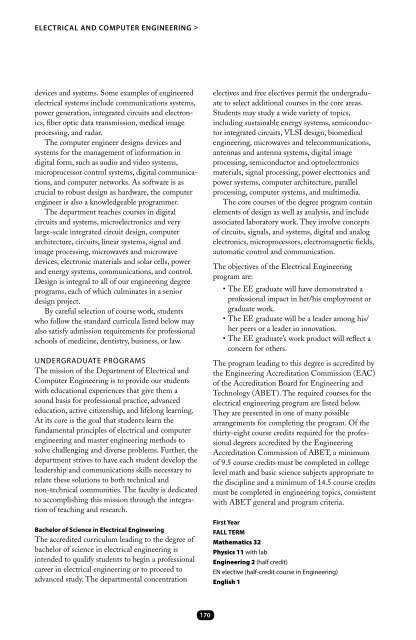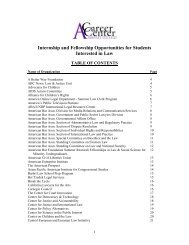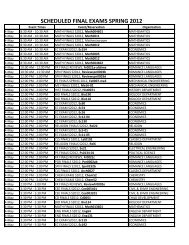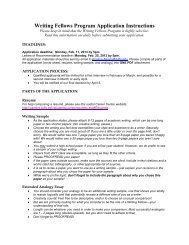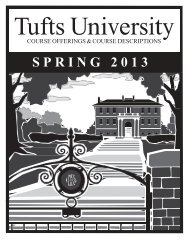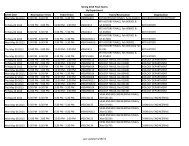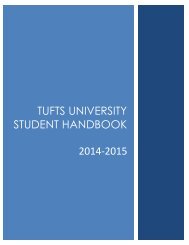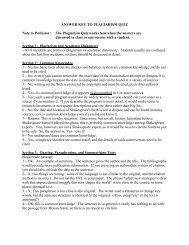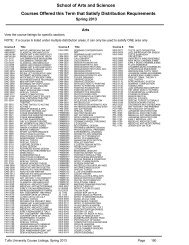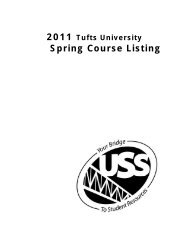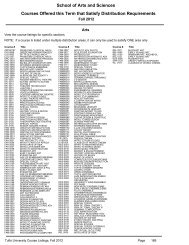2013â2014 The Bulletin - USS at Tufts - Tufts University
2013â2014 The Bulletin - USS at Tufts - Tufts University
2013â2014 The Bulletin - USS at Tufts - Tufts University
You also want an ePaper? Increase the reach of your titles
YUMPU automatically turns print PDFs into web optimized ePapers that Google loves.
Electrical and Computer Engineering ><br />
devices and systems. Some examples of engineered<br />
electrical systems include communic<strong>at</strong>ions systems,<br />
power gener<strong>at</strong>ion, integr<strong>at</strong>ed circuits and electronics,<br />
fiber optic d<strong>at</strong>a transmission, medical image<br />
processing, and radar.<br />
<strong>The</strong> computer engineer designs devices and<br />
systems for the management of inform<strong>at</strong>ion in<br />
digital form, such as audio and video systems,<br />
microprocessor control systems, digital communic<strong>at</strong>ions,<br />
and computer networks. As software is as<br />
crucial to robust design as hardware, the computer<br />
engineer is also a knowledgeable programmer.<br />
<strong>The</strong> department teaches courses in digital<br />
circuits and systems, microelectronics and very<br />
large-scale integr<strong>at</strong>ed circuit design, computer<br />
architecture, circuits, linear systems, signal and<br />
image processing, microwaves and microwave<br />
devices, electronic m<strong>at</strong>erials and solar cells, power<br />
and energy systems, communic<strong>at</strong>ions, and control.<br />
Design is integral to all of our engineering degree<br />
programs, each of which culmin<strong>at</strong>es in a senior<br />
design project.<br />
By careful selection of course work, students<br />
who follow the standard curricula listed below may<br />
also s<strong>at</strong>isfy admission requirements for professional<br />
schools of medicine, dentistry, business, or law.<br />
UNDERGRADUATE ProgrAMS<br />
<strong>The</strong> mission of the Department of Electrical and<br />
Computer Engineering is to provide our students<br />
with educ<strong>at</strong>ional experiences th<strong>at</strong> give them a<br />
sound basis for professional practice, advanced<br />
educ<strong>at</strong>ion, active citizenship, and lifelong learning.<br />
At its core is the goal th<strong>at</strong> students learn the<br />
fundamental principles of electrical and computer<br />
engineering and master engineering methods to<br />
solve challenging and diverse problems. Further, the<br />
department strives to have each student develop the<br />
leadership and communic<strong>at</strong>ions skills necessary to<br />
rel<strong>at</strong>e these solutions to both technical and<br />
non-technical communities. <strong>The</strong> faculty is dedic<strong>at</strong>ed<br />
to accomplishing this mission through the integr<strong>at</strong>ion<br />
of teaching and research.<br />
Bachelor of Science in Electrical Engineering<br />
<strong>The</strong> accredited curriculum leading to the degree of<br />
bachelor of science in electrical engineering is<br />
intended to qualify students to begin a professional<br />
career in electrical engineering or to proceed to<br />
advanced study. <strong>The</strong> departmental concentr<strong>at</strong>ion<br />
electives and free electives permit the undergradu<strong>at</strong>e<br />
to select additional courses in the core areas.<br />
Students may study a wide variety of topics,<br />
including sustainable energy systems, semiconductor<br />
integr<strong>at</strong>ed circuits, VLSI design, biomedical<br />
engineering, microwaves and telecommunic<strong>at</strong>ions,<br />
antennas and antenna systems, digital image<br />
processing, semiconductor and optoelectronics<br />
m<strong>at</strong>erials, signal processing, power electronics and<br />
power systems, computer architecture, parallel<br />
processing, computer systems, and multimedia.<br />
<strong>The</strong> core courses of the degree program contain<br />
elements of design as well as analysis, and include<br />
associ<strong>at</strong>ed labor<strong>at</strong>ory work. <strong>The</strong>y involve concepts<br />
of circuits, signals, and systems, digital and analog<br />
electronics, microprocessors, electromagnetic fields,<br />
autom<strong>at</strong>ic control and communic<strong>at</strong>ion.<br />
<strong>The</strong> objectives of the Electrical Engineering<br />
program are:<br />
• <strong>The</strong> EE gradu<strong>at</strong>e will have demonstr<strong>at</strong>ed a<br />
professional impact in her/his employment or<br />
gradu<strong>at</strong>e work.<br />
• <strong>The</strong> EE gradu<strong>at</strong>e will be a leader among his/<br />
her peers or a leader in innov<strong>at</strong>ion.<br />
• <strong>The</strong> EE gradu<strong>at</strong>e’s work product will reflect a<br />
concern for others.<br />
<strong>The</strong> program leading to this degree is accredited by<br />
the Engineering Accredit<strong>at</strong>ion Commission (EAC)<br />
of the Accredit<strong>at</strong>ion Board for Engineering and<br />
Technology (ABET). <strong>The</strong> required courses for the<br />
electrical engineering program are listed below.<br />
<strong>The</strong>y are presented in one of many possible<br />
arrangements for completing the program. Of the<br />
thirty-eight course credits required for the professional<br />
degrees accredited by the Engineering<br />
Accredit<strong>at</strong>ion Commission of ABET, a minimum<br />
of 9.5 course credits must be completed in college<br />
level m<strong>at</strong>h and basic science subjects appropri<strong>at</strong>e to<br />
the discipline and a minimum of 14.5 course credits<br />
must be completed in engineering topics, consistent<br />
with ABET general and program criteria.<br />
First Year<br />
FALL TERM<br />
M<strong>at</strong>hem<strong>at</strong>ics 32<br />
Physics 11 with lab<br />
Engineering 2 (half credit)<br />
EN elective (half-credit course in Engineering)<br />
English 1<br />
170


